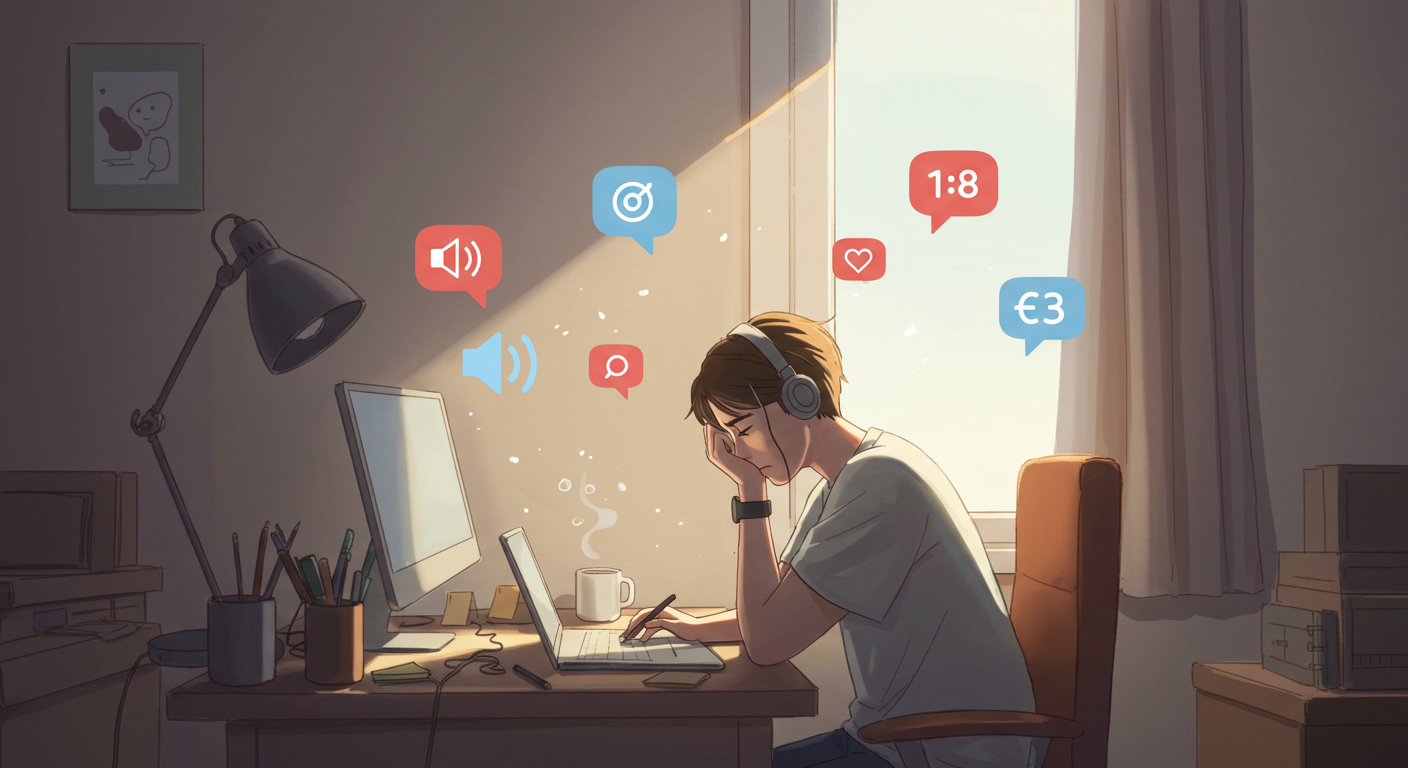Hidden Anxiety TriggersIntroduction
Hidden anxiety triggers are subtle factors that often go unnoticed yet influence emotions, behavior, and daily stress.
Many people feel anxious without understanding the cause because these triggers are invisible to awareness.
Obvious stressors, like deadlines or conflicts, are easy to identify.
However, minor, constant cues quietly fuel tension and affect mental and physical health.
Studies show that chronic low-level stress can reduce focus, impair sleep, and increase irritability over time.
For example, I once woke up anxious despite a calm day ahead.
At first, I assumed it was a fleeting mood, but after journaling, I noticed patterns.
Certain background noises, screen usage, and even internal perfectionism were creating hidden tension.
Awareness is the first step.
Once hidden triggers are recognized, small adjustments can significantly reduce anxiety.
This article explores the most common hidden anxiety triggers and practical strategies to manage them.
Key Note: Hidden triggers are small, unnoticed factors that can significantly increase anxiety levels.

Environmental Hidden Anxiety Triggers
Your surroundings silently shape your emotional state.
Lighting, noise, clutter, and other environmental factors often increase anxiety without conscious awareness.
These triggers are subtle but persistent, gradually building stress over time.
Background Noise
Continuous sounds, like traffic, office chatter, or notifications, keep your nervous system active.
Even sounds you barely notice, such as a humming appliance or distant conversations, can elevate stress over time.
For example, I worked in a bustling café for several days.
Although I thought the chatter was background ambiance, my heart raced at night.
Sleep became restless, and my focus during work hours decreased.
I realized the noise was a hidden anxiety trigger affecting my nervous system without my conscious awareness.
To manage this, consider noise-canceling headphones, soft music, or relocating to quieter spaces.
Scheduling quiet breaks can also reduce cumulative stress.
Moreover, awareness of background noise allows you to mentally prepare for unavoidable sounds.
As a result, you regain control and decrease subtle tension in daily life.
Key Note: Unnoticed background noise can silently elevate anxiety levels and should be managed proactively.
Lighting & Organization
Lighting and environment play a bigger role than most people realize.
Harsh fluorescent lights or dimly lit rooms can subtly increase anxiety.
Similarly, cluttered spaces create visual overload, which stresses the brain unconsciously.
For instance, I once worked in a small, dark office.
Over days, tension and irritability increased without obvious cause.
Opening windows, adding natural light, and organizing my desk reduced anxiety significantly.
Light color and intensity affect mood. Warm natural light promotes calm, while harsh, cool light increases alertness and tension.
Additionally, maintaining an organized space reduces mental load.
Simple adjustments, like tidying papers, arranging furniture, or adding plants, create a more relaxed environment.
In addition, consistent routines, like decluttering daily, prevent hidden triggers from accumulating.
These small but intentional environmental changes can drastically reduce anxiety over time.
Key Note: Environmental factors, including lighting and organization, act as hidden anxiety triggers that can be controlled.
Lifestyle Hidden Anxiety Triggers
Daily habits contribute significantly to hidden anxiety.
Caffeine, sugar, poor diet, and excessive digital exposure can mimic anxiety symptoms and exacerbate stress.
Often, people overlook how these routines influence their nervous system.
Diet & Caffeine
Caffeine increases alertness but can also mimic anxiety symptoms, like rapid heartbeat or nervous energy.
Sugar and processed foods create energy spikes followed by crashes, destabilizing mood and focus.
For example, I replaced my morning coffee with herbal tea.
Within days, my restlessness decreased, and I felt calmer in the mornings.
Similarly, reducing processed foods stabilized my energy and lowered subtle tension throughout the day.
Moderating caffeine intake, balancing meals with protein and fiber, and avoiding sugar crashes all reduce hidden anxiety triggers.
Moreover, staying hydrated prevents physiological stress signals that mimic anxiety.
By monitoring dietary choices and observing their effects on mood, you can identify patterns.
As a result, small lifestyle changes produce significant reductions in anxiety.
Key Note: Diet and caffeine are common hidden triggers that quietly elevate anxiety.
Digital Overload
Screens dominate modern life.
Notifications, social media, emails, and constant multitasking overstimulate the brain, producing subtle stress.
Even neutral scrolling can trigger tension, while social comparison amplifies anxiety.
For example, I noticed late-night phone use caused restless thoughts and difficulty sleeping.
After limiting screen time and silencing notifications, my sleep improved and my morning anxiety decreased.
Digital exposure sends signals of urgency to the brain, even when the situation isn’t critical.
Multitasking across apps increases cognitive load, heightening hidden anxiety triggers.
To manage this, schedule device-free hours, silence notifications, and scroll mindfully.
Awareness of these triggers allows you to set boundaries and reduce cumulative stress.
As a result, energy levels and focus improve, while hidden anxiety triggers diminish.
Key Note: Digital overload is a modern, often overlooked hidden trigger that subtly increases anxiety.
Emotional & Psychological Hidden Anxiety Triggers
Internal factors often drive hidden anxiety.
Suppressed emotions, self-criticism, and perfectionism quietly generate tension and stress.
Suppressed Emotions
Avoiding anger, sadness, or frustration may feel harmless but allows tension to build unconsciously.
For example, during therapy training, I realized suppressing anger increased restlessness and nervous energy.
Unprocessed emotions trigger the body’s stress response, causing physical symptoms like shallow breathing or muscle tension.
Chronic suppression reinforces hidden anxiety patterns over time.
Expressing emotions through journaling, conversation, or mindfulness exercises releases this tension.
Awareness of emotional triggers helps you anticipate and manage stress before it escalates.
As a result, anxiety becomes more controllable, and emotional resilience strengthens.
Key Note: Suppressed emotions are internal hidden triggers that can lead to unexplained anxiety.
Perfectionism & Inner Critic
Perfectionism silently fuels anxiety.
Constant self-checking, over-preparing, and harsh self-criticism create invisible tension.
For example, I once edited a short article for hours, seeking nonexistent mistakes.
The hidden trigger was my inner critic, not the work itself.
Perfectionism reinforces stress cycles, making minor tasks feel overwhelming.
Breaking perfectionist habits reduces hidden triggers.
Set realistic expectations, limit revisions, and practice self-compassion.
Over time, small adjustments reduce cumulative anxiety, creating a calmer mental state.
Awareness of perfectionism patterns allows proactive interventions.
As a result, hidden psychological triggers become manageable rather than overwhelming.
Key Note: Perfectionism and self-criticism are powerful internal hidden triggers.
Physical & Social Hidden Anxiety Triggers
Your body and social environment subtly affect anxiety levels.
Muscle tension, posture, and small social cues reinforce hidden stress without awareness.
Body Tension
Jaw clenching, shallow breathing, and stiff shoulders signal danger to the brain, increasing stress.
Even minor tension accumulates over time, maintaining anxious states.
Daily practices like stretching, yoga, and progressive relaxation release tension.
For example, a few minutes of mindful breathing before work reduced my overall nervous energy.
Monitoring physical cues allows recognition of stress before it escalates.
Body awareness creates feedback loops.
Relaxing muscles signals safety to the brain, lowering hidden anxiety triggers.
As a result, mental clarity and emotional balance improve significantly.
Key Note: Body tension is a silent hidden trigger that amplifies anxiety.
Social Micro-Interactions
Small social cues, like tone, facial expressions, or subtle remarks, can trigger anxiety unconsciously.
A minor sarcastic comment at work, for example, caused stress to linger all day.
Social triggers are often overlooked because they are subtle and indirect.
However, cumulative effects influence mood, self-perception, and behavior.
Reflecting on interactions and practicing mindfulness reduces the impact of minor social stressors.
Additionally, open communication prevents small issues from escalating.
Being aware of hidden social triggers allows proactive management and emotional regulation.
As a result, relationships feel less stressful, and anxiety decreases over time.
Key Note: Subtle social interactions silently contribute to hidden anxiety triggers.
Strategies to Manage Hidden Anxiety Triggers
Awareness and proactive action reduce hidden anxiety triggers.
- Track Triggers: Keep a journal of mood, environment, diet, and physical tension.
- Environment: Adjust lighting, reduce noise, and organize your space.
- Digital Detox: Silence notifications and limit screen use before sleep.
- Body & Mind: Stretch, breathe deeply, and practice progressive relaxation.
- Emotion Expression: Journal, meditate, or talk to a trusted friend.
- Lifestyle Choices: Moderate caffeine, sugar, and processed food to stabilize energy and mood.
Transition words like for example, however, therefore, moreover, and as a result improve readability and help connect ideas.
Consistency is key. Daily small steps prevent triggers from escalating.
Over time, managing hidden anxiety triggers increases resilience, focus, and emotional calm. listen to Bamboo Flute Music Soojz | The Mind Studio
Key Note: Simple, consistent strategies reduce hidden anxiety and restore balance.
Hidden Anxiety Triggers Conclusion
Hidden anxiety triggers are subtle yet powerful influences in daily life.
Environmental cues, lifestyle habits, suppressed emotions, body tension, and social interactions all contribute quietly.
Recognizing these triggers allows proactive management.
Small adjustments, like improving lighting, reducing noise, moderating diet, and practicing mindfulness, can dramatically lower anxiety.
Awareness and daily tracking prevent minor triggers from escalating into chronic stress.
By implementing strategies consistently, hidden anxiety triggers lose power.
Your emotional resilience improves, sleep quality increases, and mental clarity strengthens.
Even small actions, like journaling or mindful breathing, create significant long-term benefits.
Therefore, explore your hidden triggers today.
Awareness is the first step toward turning anxiety into a manageable, calm experience.
With practice, hidden anxiety triggers transform from silent saboteurs into controllable aspects of daily life.
Key Note: Recognizing and managing hidden triggers empowers you to regain emotional balance and reduce anxiety.
read more : Anxiety : why Your Brain Actually Loves Anxiety






